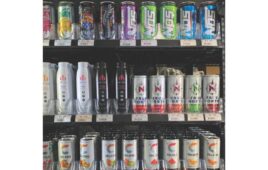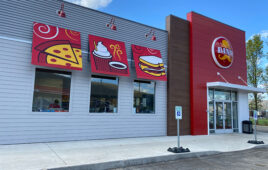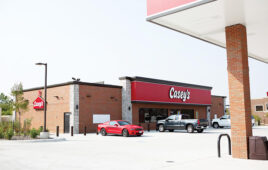According to U.S. Census Bureau data released in 2017, consumers nationwide spend an estimated $5.8 billion at car wash businesses every year. That total represents eight million vehicles being washed on a daily basis.
The International Carwash Association analyzes the market further, stating 90% of car washes in the U.S. are owned and operated by small business owners instead of corporate conglomerates and about 37% of car wash owners have owned their business for less than five years. Profits can average around from $41,000 a year for a self-service car wash to over $680,000 for a full-service business.
According to a 2017 report from the research firm IBISWorld, annual industry growth within the car wash market will continue through 2021 at an estimated 1.7% spike.
So what’s the driver behind these sparkling figures? Perhaps a better question is: Why do numerous retailers continue to invest big money in such large capital projects?
Well, when the planning is done right, good environmental site assessments are made—including scoping out the competitive landscape—the return on investment can be stellar.
Michael Meyer, facility operations officer at Teutopolis, Ill.-based Meyer Oil Co., has overseen the installation of 10 automatic car wash bays at the company’s Mach 1 convenience chain. All 10 wash systems from D&S Car Wash Equipment Co. are located in central and southern Illinois.
CLEAN SWEEP
Customers are always looking for something new and exciting, Meyer said, whether it is a tire shine or hot wax or finding different ways to save money or feel appreciated for their purchase.
“We have started adding Hot Foaming Wax at all new locations and went back and included it in higher volume locations,” said Meyer. “This gives us another opportunity to increase the ticket price to the customer. Customers are always willing to pay a top shelf price if they know they are getting top shelf product in return.”
In addition to in-bay automatic car wash systems, Mach 1 works to entice customers outside the interior bay.
“Investments have been made at our last several sites to offer free vacuums to our customers,” Meyer said. “This has been an amazing draw for our customers to pull onto our lots and we have decided the more times they are on our lot the better. That is when they decide to make a purchase inside our convenience store and go through
our car wash.”
There are a variety of car wash options on the market today, and you can see all of them in the c-store channel. Often the
two classifications that are considered when retailers tackle an installation are touchless and friction. For some time, touchless car washes were considered an enviable option over conveyor types because they are considered by many to be more delicate on a vehicle’s surface.
The last year or so the development of new materials such as soft-touch foam brushes have tilted the market back to the middle, in terms of professional opinion, said Chuck Space, executive director of the Southwest Car Wash Association, based in Austin, Texas.
“For a time, the touchless was the trending operation. However there seems to be a trend now back to the friction,” said Space. “Now with the expanding market of the express exterior and the development of better equipment and products most of the fear of the friction car wash has been removed. And the operator and consumer are experiencing a better product with friction.”
CONVENIENCE FACTOR
Aside from the obvious considerations of what goes into car wash planning, including environmental strategies, financing and site assessments, another weighty topic of whether a car wash complements a retail operation is the factor of convenience. Getting customers in and out of both the c-store and from the confines of the car wash in a timely manner is key.
One technological upgrade that is becoming more popular in car wash operations is RFID (radio-frequency identification) technology. When a customer is enrolled into the retailer’s subscription program, patrons are issued an RFID tag. This tag will be loaded with all of the customer’s information and then adhered to the inside of the windshield. When the customer pulls into the wash, the RFID tag and the RFID antenna communicate, allowing the driver to proceed without having to stop and pay.
However, some customers might take advantage of the program, said Meyer. “We have two locations that offer an RFID program and while they are great tools to attract customer loyalty, there is some abuse with customers and that results in thinner than optimal margin. New and future sites do not offer RFID.”
There are other car wash programs that can speed up service and better engage customers.
Some industry experts explain retailers can expand their monthly strategies to include membership packages other than unlimited. Commercial fleet accounts also can enjoy the benefits of a recurring charge or discounted group rate for such services as car washing.
However, while the systems and technologies are similar, successful car washes take a different approach with these accounts. Innovations that can get the motorist in and out quickly can pay dividends, Space said.
“Wash clubs or loyalty programs have been a big time saver because the customer spends less time at the pay station,” Space said. “Express exterior has produced a faster wash process by leaving the customer in the car. Better chemistry and equipment have helped save time and labor.”
FUTURISIC FORMATS
Another car wash offering that gained attention in 2017 is the express-exterior wash model, which has been around for a few years, but is now becoming a more significant part of the car wash footprint.
“Express exteriors are being built at a very rapid pace, which will create a more competitive market for the other models,” Space said. “Car wash services will get more competitive and we will see more club passes/loyalty programs as more investors enter the market. Larger companies are entering or expanding in the market and could make it very difficult for the smaller operations and stores to compete.”




